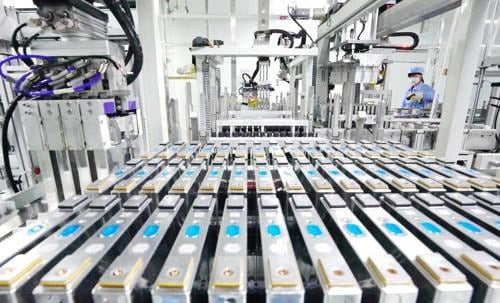LG expands production capacity
Samsung, all-solid battery game
SK accelerates material internalization

Photo = XINHUA
The global competition in the electric vehicle battery market is getting fiercer day by day. As car makers such as Volkswagen Tesla have declared that they will directly produce batteries, existing battery companies that have dominated the market are very nervous. This is why’three K battery companies’ such as LG Energy Solution, Samsung SDI, and SK Innovation, which accounted for about 35% of the global market last year, are making large-scale investments with desperate feelings. There are some differences in the investment strategies of these companies. LG puts production capacity expansion as a top priority, and Samsung puts R&D as the top priority. SK is focusing on internalizing battery materials.
LG invests 3 trillion won in facility investment
According to the industry on the 23rd, last year’s R&D investment for the three domestic battery companies was KRW 2.2014 trillion, up 6.2% from the previous year (KRW 2.71 trillion). A little more than half of this was KRW 1.1392 trillion, which was invested by LG Chem, the parent company of LG Energy Solutions. However, the increase in R&D costs was not significant. It is an influence more focused on technology protection and production capacity expansion.

LG Energy Solutions’ R&D investment exceeded KRW 600 billion in 2016 (based on LG Chem), KRW 800 billion in 2017, and KRW 1 trillion in 2018. The increase has decreased slightly since 2019, when the battery technology dispute with SK Innovation began in earnest. Since then, he has focused on Mercury as much as technology development. It is known that hundreds of billions of billion won have been invested only in litigation for technical disputes.
On the one hand, it started to expand production capacity. This is because the order was too crowded to handle it. Building more factories and increasing facilities has become more important than R&D. The production capacity, which was only 35GWh per year in 2018, has been increased to 70GWh in 2019 and 120GWh last year. More than 3 trillion won per year, more than three times the R&D cost, was invested in facility investment. Most of the business plans that LG Energy Solutions recently revealed were also about increasing production capacity.
13% increase in R&D investment… Samsung, focus on new technology
Samsung SDI focused more on technology development. Last year’s R&D investment was 808.3 billion won, a 13% increase from the previous year (712.5 billion won). The number of intellectual property rights (IP) registrations such as patents (including pending) was 24,385, an increase of 7.6% from the previous year. Most of the increase was related to foreign patents.
Samsung SDI has suffered from a battery fire accident in the Samsung Electronics smartphone in the past. It suffered a deficit and image damage following a massive recall. Afterwards, the group took a life and death in securing battery safety. In particular, it is promoting the development of a’all-solid-state battery’ that has a small possibility of fire and can greatly improve the mileage. In March of last year, the Samsung Advanced Institute of Technology introduced an all-solid battery using lithium cathode technology. The industry expects that Samsung SDI will take over the production of this product. After testing, it is analyzed that mass production will be possible as early as 2027.
SK Ino expands battery materials
The characteristic of SK Innovation’s battery investment is its expansion in the material sector.
The battery separator, which is being produced through its subsidiary SK I Technology (SKIET), boasts the world’s best quality along with Japan’s Asahi Kasei and Toray. Even if the price is high, it is not enough to sell. Last year, the company achieved sales of 4317 billion won and operating profit of 125.9 billion won. The operating margin reached 29.1%. As separator damage became a key issue in the battery fire accident, the demand for SKIET separators is expected to increase rapidly in the future.
It’s not just the separator. SK Innovation has plans to internalize other materials such as cathode materials. At a recent company briefing session (IR), he said, “As the production scale of batteries increases, the stability of supply of cathode materials, which is a key material, is becoming more important.”
Reporter Ahn Jae-kwang [email protected]
